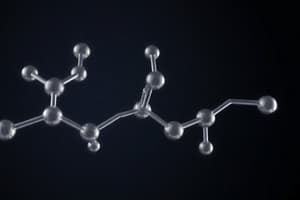Podcast
Questions and Answers
What happens to Km in the presence of a competitive inhibitor?
What happens to Km in the presence of a competitive inhibitor?
- Decreases
- Becomes zero
- Increases (correct)
- Remains constant
Non-competitive inhibitors bind to the active site of an enzyme.
Non-competitive inhibitors bind to the active site of an enzyme.
False (B)
List one example of a drug that acts as a non-competitive inhibitor.
List one example of a drug that acts as a non-competitive inhibitor.
There are several possibilities such as certain cancer chemotherapy agents.
The drug __________ is used for the treatment of gout and acts as a competitive inhibitor.
The drug __________ is used for the treatment of gout and acts as a competitive inhibitor.
Match the type of inhibitor with its characteristic:
Match the type of inhibitor with its characteristic:
Which of the following statements is true regarding non-competitive inhibitors?
Which of the following statements is true regarding non-competitive inhibitors?
Allosteric inhibitors bind to the active site of the enzyme.
Allosteric inhibitors bind to the active site of the enzyme.
What is a common example of an allosteric inhibitor mentioned?
What is a common example of an allosteric inhibitor mentioned?
In feedback inhibition, the _____ product inhibits the activity of an early enzyme.
In feedback inhibition, the _____ product inhibits the activity of an early enzyme.
Match the following enzyme inhibition types with their characteristics:
Match the following enzyme inhibition types with their characteristics:
Flashcards
Competitive Enzyme Inhibition
Competitive Enzyme Inhibition
A type of reversible enzyme inhibition where an inhibitor competes with the substrate for the enzyme's active site.
Non-competitive enzyme Inhibition
Non-competitive enzyme Inhibition
A type of reversible enzyme inhibition where an inhibitor does not compete with the substrate for the enzyme's active site; rather, it binds to a separate site on the enzyme, changing its shape and reducing activity.
Enzyme Inhibitors (Clinical Use)
Enzyme Inhibitors (Clinical Use)
Drugs that slow or stop enzyme function to treat illnesses like hypercholesterolemia, gout, and infection.
Competitive inhibitors - Effect on Km and Vmax
Competitive inhibitors - Effect on Km and Vmax
Signup and view all the flashcards
Allopurinol
Allopurinol
Signup and view all the flashcards
Non-competitive inhibitor
Non-competitive inhibitor
Signup and view all the flashcards
Allosteric inhibitor
Allosteric inhibitor
Signup and view all the flashcards
Feedback inhibition
Feedback inhibition
Signup and view all the flashcards
Competitive inhibitor
Competitive inhibitor
Signup and view all the flashcards
Reversible inhibition
Reversible inhibition
Signup and view all the flashcards
Study Notes
Enzyme Inhibition Lecture Notes
- The lecture covered enzyme inhibition, specifically focusing on different types of enzyme inhibition, comparisons of various inhibitors, and examples of drugs acting as enzyme inhibitors in clinical practice.
Lecture Objectives
- Explain the different types of enzyme inhibition.
- Compare reversible competitive to non-competitive enzyme inhibitors and allosteric inhibitors.
- List some examples of drugs acting as enzyme inhibitors in clinical practice.
Why Need Enzyme Inhibitors?
- This section discusses the necessity of enzyme inhibitors.
Types of Enzyme Inhibition
-
Reversible Inhibitors:
- Competitive: Structural similarity to the substrate, competes for the active site, reversible by increasing substrate concentration. Increased Km, Vmax constant, increased slope on Lineweaver-Burk plot.
- Non-competitive: No structural similarity to the substrate, binds to a site other than the active site, absolute concentration of inhibitor, not reversed by increasing substrate concentration. Km constant, decreased Vmax, increased slope on Lineweaver-Burk plot.
- Allosteric: Small organic molecules bind to an allosteric site, changing enzyme conformation, affecting substrate binding, Km increased or Vmax decreased.
-
Irreversible Inhibitors:
- Cofactor/coenzyme: Inhibitor interferes with cofactor/coenzyme binding.
- Denaturation/ppt: Inhibitor causes enzyme denaturation.
- SH group: Inhibitor reacts with SH group of the enzyme.
- Anti-enzymes: Inhibitor is a protein that inhibits specific enzymes.
Competitive Inhibitors (Substrate Analogue Inhibitors)
- Structural similarity between substrate and inhibitor.
- Both compete for the active site.
- Relative concentration of substrate and inhibitor.
- Reversed by increasing substrate concentration.
- Km increased, Vmax constant.
- The slope is increased on Lineweaver-Burk plot
Examples of Competitive Inhibitors
- Sulfanilamide: Bacteriostatic, a PABA analogue.
- Allopurinol: Used in gout treatment.
- Dicumarol & Warfarin: Anti-coagulants.
- Statins: Competitive inhibitors of HMG-CoA reductase, used in hypercholesterolemia treatment.
Non-Competitive Inhibitors
- No structural similarity between substrate and inhibitor.
- No competition for the active site.
- Bind to a site other than the active site.
- Absolute concentration of inhibitor.
- Not reversed by increasing substrate concentration.
- Km constant, Vmax decreased.
- The slope is increased on Lineweaver-Burk plot.
Examples of Non-Competitive Inhibitors
- Captopril: Angiotensin-converting enzyme (ACE) inhibitor used in hypertension treatment.
Allosteric Inhibitors
- Small organic molecules.
- Bind to the allosteric site.
- Produce conformational change, making binding to substrate less suitable (decrease enzyme activity).
- Km increased or/and Vmax decreased.
Allosteric Feedback Inhibition
- End product inhibits the activity of an early enzyme within a pathway.
- Usually irreversible.
- Important in metabolic regulation.
- ATP is an example (inhibits phosphofructokinase, a key enzyme in glycolysis).
Summary
- Reversible enzyme inhibition.
- Competitive inhibitors.
- Non-competitive inhibitors.
- Allosteric inhibitors.
Studying That Suits You
Use AI to generate personalized quizzes and flashcards to suit your learning preferences.




